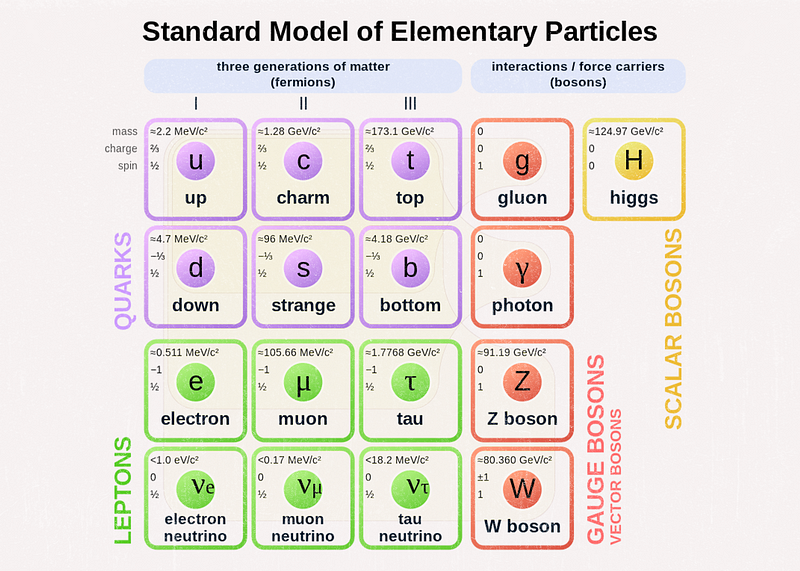Unveiling the Major Shortcomings of the Standard Model in Physics
Written on
Chapter 1: Introduction to the Standard Model's Limitations
The Standard Model of particle physics serves as a cornerstone in our understanding of the fundamental forces and particles in the universe. However, it has notable shortcomings that challenge its completeness and applicability. These limitations encompass aspects that the model fails to elucidate or predict, as well as contradictions with experimental observations or established theories.
Section 1.1: The Absence of Gravity
A significant flaw in the Standard Model is its failure to incorporate gravity, one of the four essential forces in nature. This omission leaves unanswered questions regarding the vast difference in strength between gravity and the electromagnetic or nuclear forces. For instance, consider how a small refrigerator magnet can overcome the gravitational pull of an entire planet on a tiny object.
The Standard Model relies on quantum field theory, which accounts for particle interactions through quantum fields and force carriers. Yet, there exists no consistent quantum field theory of gravity that aligns with the Standard Model. General relativity, the prevailing theory of gravity, describes it as a result of space-time curvature caused by mass and energy. However, this classical theory does not integrate quantum mechanics, resulting in a disconnect between these two frameworks and hindering a unified theory of fundamental interactions.

Section 1.2: Dark Matter and Dark Energy
Another critical issue with the Standard Model is its inability to account for dark matter and dark energy, which constitute the majority of the universe's energy density but consist of no known particles.
Dark matter is a theoretical form of matter that interacts solely through gravity, inferred from its gravitational influence on visible matter like galaxies. It is estimated to make up about 27% of the universe's total mass-energy, whereas ordinary matter (composed of Standard Model particles) accounts for only about 5%. The exact nature and origin of dark matter remain elusive, but potential candidates include weakly interacting massive particles (WIMPs), axions, or sterile neutrinos.
Dark energy, on the other hand, is hypothesized to exist throughout space, propelling the universe's accelerated expansion. Evidence for dark energy arises from observations of distant supernovae and the cosmic microwave background radiation, with estimates suggesting it comprises about 68% of the universe's total mass-energy. Its nature and origin are still subjects of speculation, with explanations ranging from a cosmological constant to dynamic fields like quintessence.
The first video titled "Standard Model of Particle Physics Explains Everything Except THIS" explores these limitations in detail, shedding light on the gaps left by the Standard Model.
Section 1.3: Neutrino Masses and Oscillations
The Standard Model further falters by not incorporating neutrino oscillations and their non-zero masses, necessitating an expansion of the lepton sector.
Neutrinos, which are electrically neutral leptons, interact weakly with other particles and exist in three types: electron neutrinos, muon neutrinos, and tau neutrinos. Initially, the Standard Model posited that neutrinos are massless and do not mix. However, observations from the Super-Kamiokande experiment in 1998 indicated neutrino oscillations, suggesting that these particles possess mass and can interchange between types as they travel through space or matter.
This phenomenon has been corroborated by subsequent experiments, but the Standard Model does not account for the underlying mechanisms of neutrino masses and oscillations. One potential extension involves introducing right-handed neutrinos that interact with the Higgs boson, allowing for the generation of mass through similar processes as other fermions. However, this would imply that neutrinos are Majorana particles, which remains unverified.

Chapter 2: Other Significant Limitations
In the video "The STANDARD MODEL: A Theory of (almost) EVERYTHING Explained," the presenter elaborates on these and other deficiencies of the Standard Model, encouraging viewers to consider the implications for our understanding of physics.
Section 2.1: The Hierarchy Problem
The hierarchy problem represents another significant challenge for the Standard Model, highlighting the vast disparity between the gravitational scale and the electroweak scale.
The gravitational scale is defined by the Planck mass, approximately 10¹? GeV/c², where quantum gravitational effects become relevant. In contrast, the electroweak scale is indicated by the Higgs boson mass, around 125 GeV/c². The stark contrast between these scales—spanning 16 orders of magnitude—raises questions about the underlying reasons for such a discrepancy. Quantum corrections to the Higgs mass should align with the highest energy scale in the theory, yet this would suggest a Higgs mass much larger than what is observed, unless there is precise cancellation between various contributions. This fine-tuning requirement is deemed unsatisfactory by many physicists.
To address the hierarchy problem, theorists propose introducing new symmetries or particles that could stabilize the Higgs mass and mitigate quantum corrections. Supersymmetry, which posits a symmetry between fermions and bosons, is one such approach, predicting a partner for every known particle. Despite the promise of this theory, no supporting evidence has been uncovered in recent experiments, including those at the LHC.

Section 2.2: Flavor Physics and CP Violation
Another aspect the Standard Model struggles to explain is flavor physics and CP violation, which relate to the masses and mixing angles of quarks and leptons.
Flavor physics examines how quarks and leptons transition between different flavors through weak interactions. For instance, a down quark can transform into an up quark through the emission of a W boson, which subsequently decays into an electron and an electron antineutrino. The probabilities governing these flavor-changing processes are dictated by the masses and mixing angles of these particles, encapsulated in the Cabibbo-Kobayashi-Maskawa (CKM) matrix for quarks and the Pontecorvo-Maki-Nakagawa-Sakata (PMNS) matrix for leptons.
CP violation refers to the phenomenon where certain processes do not remain unchanged under the combined operations of charge conjugation and parity inversion. This implies that some processes behave differently for matter and antimatter, which is crucial for understanding the matter-antimatter asymmetry observed in the universe. The Standard Model fails to explain the origins of the CKM and PMNS matrices' parameters, which are treated as free inputs requiring experimental measurement. The predicted level of CP violation is insufficient to account for the observed asymmetry, indicating the need for additional sources of CP violation beyond the Standard Model.
In conclusion, these limitations of the Standard Model of particle physics drive physicists to seek new theories that extend beyond its current framework. If you're interested in exploring this topic further, consider examining the following references:
Haber, Howard E., and Gordon L. Kane. “The search for supersymmetry: probing physics beyond the standard model.” Physics Reports 117.2–4 (1985): 75–263.
Comelli, Daniele, M. Pietroni, and A. Riotto. “Dark energy and dark matter.” Physics Letters B 571.3–4 (2003): 115–120.
Bigi, Ikaros I., and A. Ichiro Sanda. “CP violation.” (2001): 1287–1287.
Thank you for taking the time to read this article. If you enjoyed it, feel free to show your support by clicking the clap icon as many times as you like.